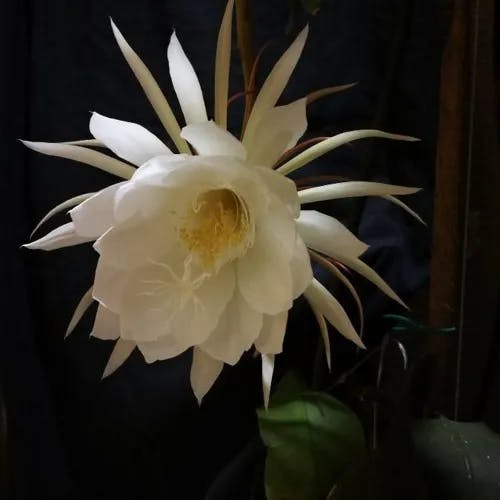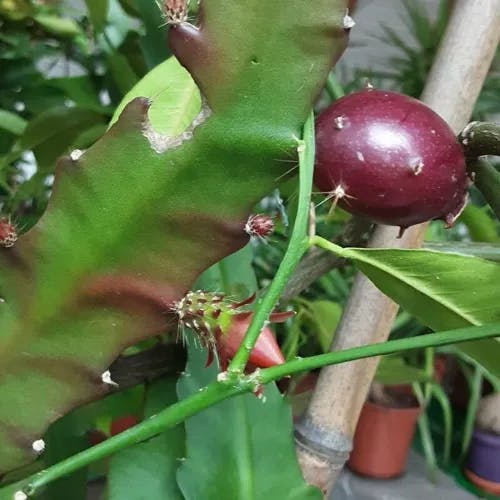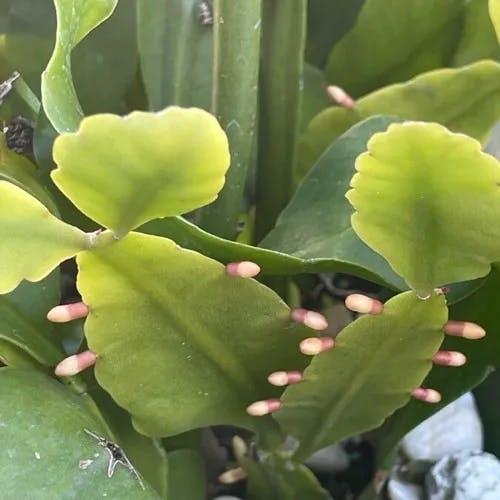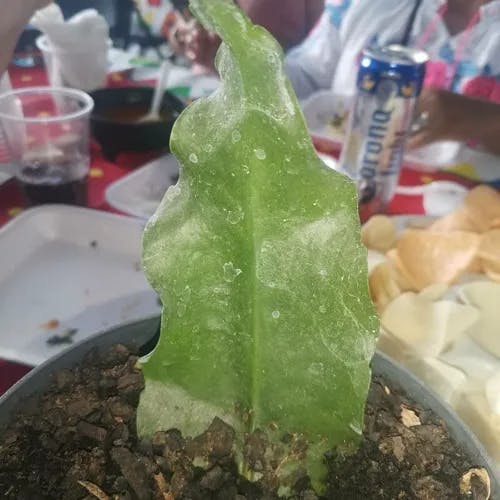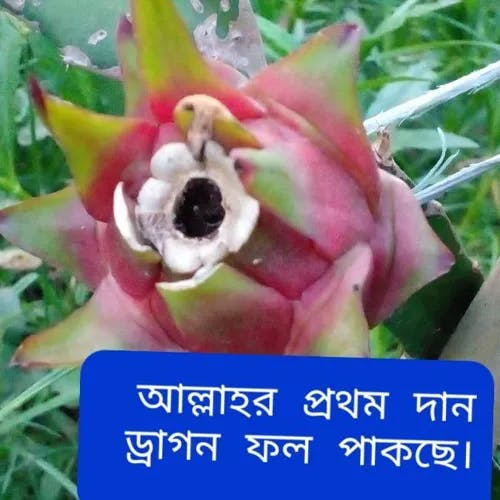The night-blooming Epiphyllum oxypetalum is an epiphytic cactus native to the Americas. This perennial plant can reach 6 meters in height but is often much smaller when potted. It has flattened stems up to 5 centimeters wide that act as leaves. The Dutchman's pipe cactus produces huge fragrant white flowers at night. These flowers can be 30 centimeters wide but vanish by sunrise. Their beauty and mystery have made the plant symbolic. There are varieties with different sized and shaped blooms. The fruit is a 5 centimeter oval berry that can be eaten despite its dull flavor. Easy to grow, this cactus needs good drainage and indirect light. It prefers warmth and humidity but tolerates a range of temperatures. Overall, the nocturnal queen of the night cactus is a fascinating indoor and outdoor plant known for its short-lived yet stunning flowers.
Queen of the Night
- Common name
- Dutchman's Pipe Cactus
- Scientific name
- Epiphyllum oxypetalum
Basic Information
- Cactaceae Family Epiphyllum Genus Queen of the Night Species
- Cactaceae > Epiphyllum > Epiphyllum oxypetalum
- 83%
- The Completeness of This Encyclopedia
Please help us complete the encyclopedia, Terrarium is a encyclopedia service to be completed with everyone in the world. Currently, this page is 83% complete. For more information on how to contribute, please click here.
- Flower
- Perennial
- Height
- 300cm ~
- Flower Color
- Leaf Color
- Anthesis
- summer
- Sunlight Exposure
Full Sun Long hours of sunlight from morning to afternoon Partial Shade A location in the shade of a tree or where either the morning or afternoon is shaded Full Shade A place where there is no direct sunlight
- Partial Shade
- Hardiness Zones
This is an indicator to know to which zone each plant can winter. Knowing the zone of each plant gives you an idea of the cold temperature resistance when grown in the ground without a roof. 2: -42.7 to -40.0 3: -39.9 to -34.4 4: -34.3 to -28.9 5: -28.8 to -23.3 6: -23.2 to -17.8 7: -17.7 to -12.2 8: -12.1 to -6.7 9: -6.6 to -1.1 10: -1.0 to 4.4 11: 4.5 to 10.0
- 10
- Cold resistance
- Poor
- Heat resistance
- Good
- Habitat of origin
- Mexico
- Growth Rate
- Normal
What is Queen of the Night (Epiphyllum oxypetalum)?
What is Queen of the Night (Epiphyllum oxypetalum)
Flower meaning
The unusual plant Epiphyllum oxypetalum, known as Dutchman's-pipe cactus, originated in Central and South America. In the coded language of flowers sometimes used in the United States, this strange plant represents magnificence during darkness or empress of nighttime. The reason is that the odd plant only blooms after sunset, displaying its big, fragrant, extremely stunning white flowers. For example, the phrase magnificence during darkness might express wonder at someone's internal beauty that is not visible immediately, but becomes clear in certain situations or as time passes. However, it is not seen as a birth flower for any particular month or date. Keep in mind that the coded language of flowers can be quite different depending on culture and region, so these meanings might not apply everywhere.
Calendar of Queen of the Night (Epiphyllum oxypetalum)
Calendar
The blooms of the Dutchman's-pipe cactus, known scientifically as Epiphyllum oxypetalum, typically open at night after 8 in the evening during late spring and early summer in America. These flowers are most spectacular in May and June but sadly wilt by dawn, so their beauty is fleeting, lasting just one night in many cases. To lengthen the short blooming time, provide filtered sunlight instead of direct sun, water on a regular schedule, and keep in a slightly cooler spot. Too much water can cause root rot which prevents blooms. Early spring fertilizing with a low nitrogen product can also extend the flowering. It may take several years before a new clipping of this plant first gifts its ephemeral blossoms. One requires patience while anticipating the nocturnal flowering display.
How to grow Queen of the Night (Epiphyllum oxypetalum)
Watering
The epiphyllum oxypetalum possesses alternative names, including Dutchman's pipe cactus. This tropical organism requires targeted hydration stipulations. During spring through autumn, when the apex soil inch desiccates, irrigate copiously. This generally necessitates weekly watering, fluctuating contingent on surrounding humidity and thermal levels. In winter, dormancy transpires, necessitating diminished hydration. Irrigate minimally, exclusively with wholly arid soil, potentially biweekly or triweekly. Excessive hydration engenders rhizome putrefaction, hence drainage remains crucial. Hydration volume should moisten without waterlogging. Underestimating surpasses overestimating hydration. Calibrate watering consistency and quantity contingent on seasonal and health fluctuations.
Soil and Fertilizer
The west wind plant, furthermore perceived as the Dutch pipeflower, flourishes in adequately-depleting mud. A blend of 1 segment expanding medium, 2 segments coarse sand, as well as 1 segment peat greenery is consummate. The dirt pH ought to be marginally sharp to unbiased, somewhere in the range of 6.0 as well as 7.0. Manure ought to be applied during the developing season, from spring to mid-fall. Utilize an adjusted, water-dissolvable compost, for example, a 20-20-20, weakened to half quality. Feed each fourteen days during this period. In winter, hold back plant food to permit the plant a rest time frame. Over-manuring can prompt salt development in the dirt, which can harm the plant. Guarantee the dirt is of acceptable caliber, liberated from sickness as well as irritations. Consistently check the dirt's pH as well as supplement levels to keep up with ideal conditions. Recollect, sound soil is vital to a flourishing west wind plant.
Sunlight and Place
The tropical plant Epiphyllum oxypetalum, known as Queen of the Night or Dutchman's Pipe, thrives with indirect sun or partial shade. Direct sun can burn its leaves. Temperatures between 50 and 90 degrees Fahrenheit suit it best, although short periods of more extreme cold or heat are tolerated. Protect this plant from intense sun and heat in summer. Indoors when the temperature drops below 50 degrees in winter. Place where filtered sunlight reaches it for a minimum of 6 hours daily. Not very sturdy in full sun, so avoid positioning in direct sunlight. Its light needs make it great for inside or shaded spots outside.
Advanced Information of Queen of the Night (Epiphyllum oxypetalum)
Pruning
The practice of occasionally trimming a Dutchman's-pipe cactus helps retain its form and spur blooming. Pruning is optimal during late winter or early springtime, before the season of new growth starts. Use a sterilized, sharp blade to trim back leggy or overgrown stems to a joint, and remove any dead or sick parts. After pruning, permit the trimmed ends to callous over for a few days prior to watering to avoid rot. Regular trimming assists triggering more flowers and keeping the plant healthy. Be gentle when pruning since the stems are delicate and can readily break. Always sanitize your tools before and after trimming to prevent disease spread. After pruning, situate the plant in a well-lit area, but not direct sunlight. Sparingly water until new growth emerges.
Planting and Harvest
The cactus named Dutchman's-pipe has another identity, Epiphyllum oxypetalum. Rather than embedding in soil, this organism thrives when potted. Its climbing nature means it evolves on other plants, needing drainage in its container. To establish this specimen, fill a pot with identical sections of orchid bark, perlite, and peat. Situate the organism in the pot's center, lightly covering the roots with the mixture. When resituating, choose a slightly more extensive pot, repeating the process but eliminating any lifeless or infected roots. If development is awry, prune to healthy spots. Remember, indirect sunlight and moisture suit this fellow. Set it appropriately and hydrate regularly, avoiding overwatering and subsequent root decay. For ideal maturation, furnish it with balanced fertilizer in the growing season.
Propagation
Spread light and raised moisture have Epiphyllum oxypetalum affections. Being a vine the carnation boundless, by sprigs is distribution seductive. Until settled, filling sparingly, then irrigate often. From cleaved fruit, offspring is probable but waning. In drained terrain blend put and obscure the cutting. Many suns pass before development. Unfitting wetness decays roots so be chary. As cutback, for manifold moons reserve drying the severed extremity. Embed partly under terrain when rooted. Regarding beams, indirect is choice.
Pests and Diseases
The plant known as Dutchman's Pipe has flat stems that resemble pipes, but it is not totally hardy despite being generally enduring. Though this cactus-like plant handles intense sun, it can suffer from an array of problems if not properly cared for. Root deterioration can happen if sustained in overly damp soil as a result of overwatering. Resultingly, the roots blacken and expire. To avoid this, ensure suitable drainage when planting and refrain from oversaturation. Mealybugs and scale insects feed on fluids within the plant, causing fading and drooping, which may be fatal if uncontrolled. Careful monitoring and washing with particular soaps can defeat these menaces. Leaf blemishes and lesions may also arise from fungal infections promoted by moisture on leaves. Air flow and prevention of wet leaves, along with treatments, can alleviate fungal diseases. Lack of nutrients can induce weakness and stunted growth. Periodic fertilization provides required nutrition. Overall, despite general ruggedness, dedicated care is needed for Dutchman's Pipes to thrive.
Habitat of Queen of the Night (Epiphyllum oxypetalum)
Habitat
Toxicity of Queen of the Night (Epiphyllum oxypetalum)
Health Benefits
- edible
- Inedible
- Toxic
- No toxicity
NO DATA
Toxic for dogs and cats
NO DATA
Q&A of Queen of the Night (Epiphyllum oxypetalum)
- Is there a recommended way to choose Epiphyllum oxypetalum?
The night-blooming mulkiphyllum decays Dutchman's-pipe caterpillar, is really a cactus music with copious, sweet-smelling flowerets. When acquisitioning grains or seedlings, gaze for wholesome, energetic recordings. Seeds must be desiccated and disencumbered from shape or else manifests of sickliness. Seedlings must contain firm, verdant stems and petioles short any blots, discoloration, or annoyances. Mulkiphyllum oxypetalum embodies no multiple varieties, thereupon excerpt is grounded on the wellbeing of the distinctive implant quite than peculiar characteristics. Whensing culling a develop implant, gaze for singular with a well-developed root scheme, equally this signals a in good health, well-founded implant. Escapade implants with xanthous or wilted petioles, equally these are manifests of emphasis or sickliness. Recall, Mulkiphyllum oxypetalum prefers oblique luminosity and lofty humidity, thereupon cull an implant that has been developped in these stipulations for the premium outcomes.
0
0
- How Can You Propagate a Dutchman's Pipe Cactus?
The cactus called Dutchman's Pipe, with the scientific name Epiphyllum oxypetalum, is able to grow new plants from cuttings of its stems. To start, cut off a piece of a healthy stem, roughly 3 to 4 inches long, from the original cactus. Make the cut clean so no diseases get into the plant. Let the cutting dry out for several days until a protective callus forms over the cut end. This curing helps stop rot when you plant the cutting. After curing, put the cutting in a potting mix made for cacti, with the cut end buried about an inch deep. Water lightly until roots start to grow, which normally takes a few weeks. Remember, Epiphyllum oxypetalum likes indirect sun, so put the new plant where it gets filtered light. If cared for properly, the new Dutchman's Pipe grown from a cutting should do well.
- What Makes the Dutchman's Pipe Cactus a 'Queen of the Night'?
The Dutchman's Pipe Cactus, known scientifically as Epiphyllum oxypetalum, is frequently called the 'Monarch of Darkness' because of its one-of-a-kind blooming behaviors. This type of cactus is prominent for its big, sweet-smelling flowers that blossom only during the night, typically once annually, and wilt prior to dawn. The nighttime blooming model is an adjustment to bring in pollinators including bats and moths that are lively at night. The flowers are pale, making them very apparent in the dark, and they give off a robust, sugary scent to additionally bring in these nighttime pollinators. Moreover, the 'Monarch of Darkness' is not only a spectacle for its night-blooming flowers, but also for the rarity of the event. The bloom endures for a single night and is a sight to behold, making it a much-anticipated event among plant enthusiasts. This mix of rarity, elegance, and nighttime charm is what makes the Dutchman's Pipe Cactus a true 'Monarch of Darkness'. The Night Queen Sedum is a charming succulent plant with pinky-red flowers that open wide at dusk. As the sun sets, the flowers start to bloom, revealing their inner beauty. The ephemeral flowers only last for one night, before withering away as the sun rises. This fleeting floral display happens in mid-summer and is eagerly awaited by gardeners. The evocative name, Night Queen, conjures up images of this elegant sedum presiding over the garden as the daylight fades to dusk. The nocturnal blooming is an adaptation to entice moths to pollinate the flowers under cover of darkness. Mysterious and alluring, the Night Queen Sedum is a jewel of the nocturnal garden. The rare gift of its transient blooms is deeply appreciated by those fortunate enough to witness its mystical midnight flowering.
- What Is the Symbolism Behind the Dutchman's Pipe Cactus?
The plant dubbed Dutchman's Pipe Cactus possesses scientific name Epiphyllum oxypetalum. Its infrequent nighttime flowering elicits intrigue. The large, white, fragrant blossoms represent innocence and transcendence, contrasting the rough exterior. This juxtaposition signifies tenacity and unforeseen splendor. Moreover, some cultures associate the sporadic blooming with fortune. Hence, incorporation into rituals or cherished houseplants. In essence, the symbolism stems from the uncommon gorgeous flowers, denoting enigma, virtue, grit, and prosperity.
0
0
